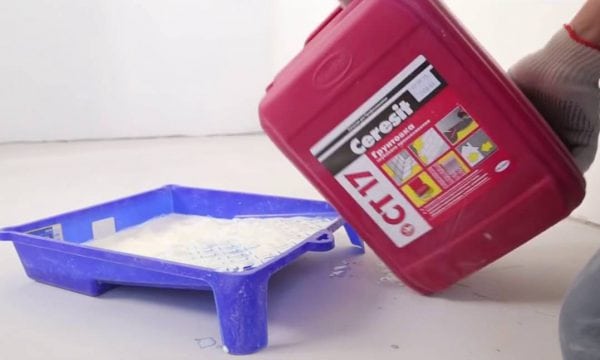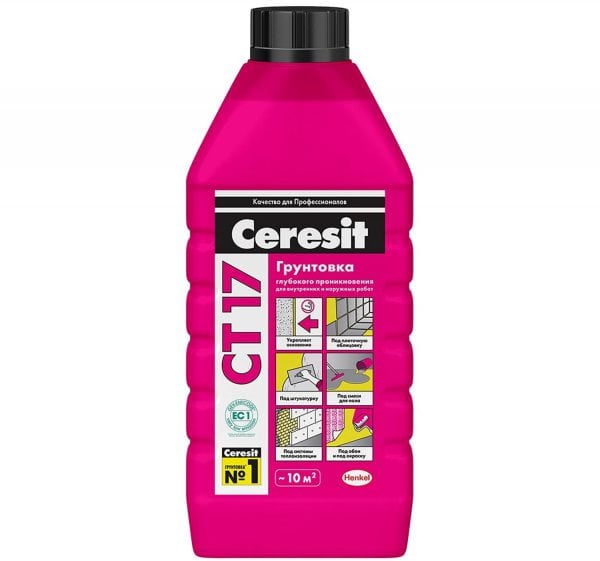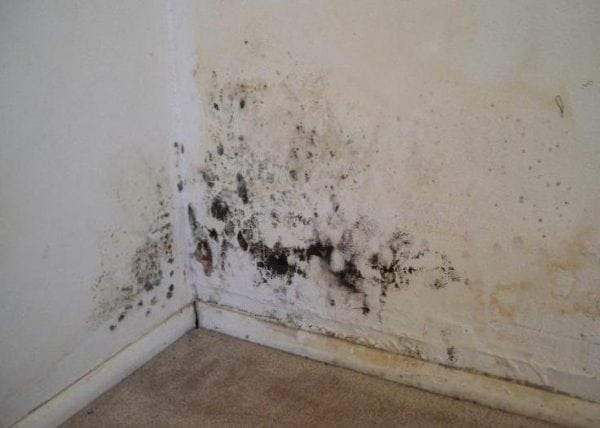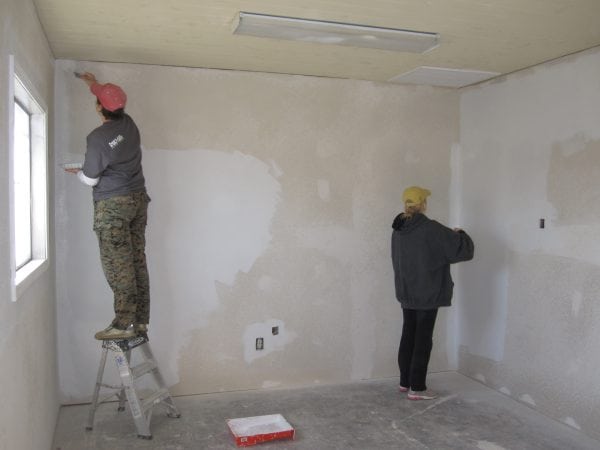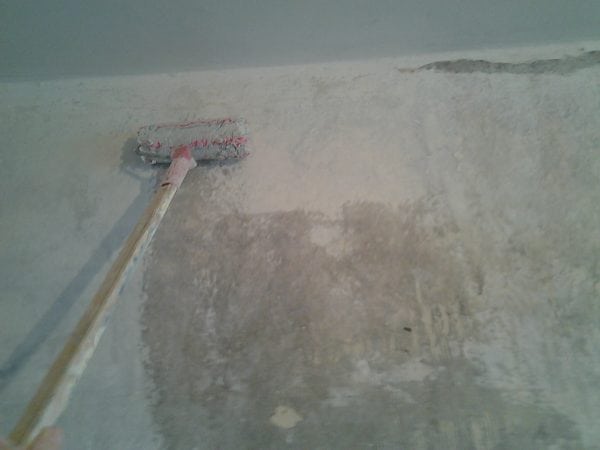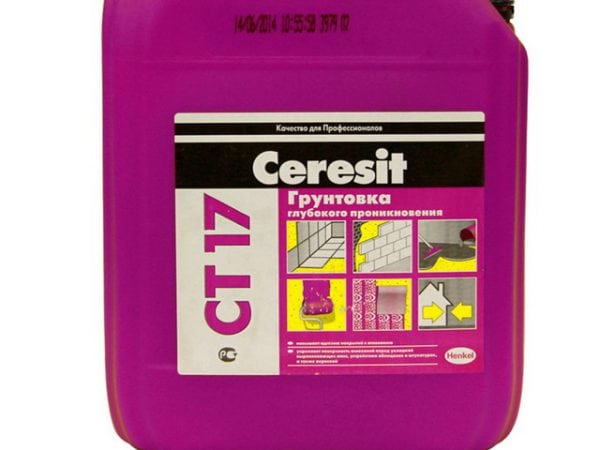Primers find their application in many areas - in everyday life, in construction. This finishing material is used for surface treatment in order to increase their protective and operational properties. The range of products that are intended for priming is very wide. High quality primer Ceresit CT 17.
- Primer properties
- Product Features
- Protective Primer Functions
- The scope of the tool
- How to prepare a surface - rules
- Priming
- Consumption rates
- Advantages and disadvantages of the primer
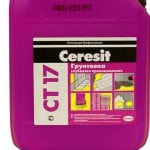
Primer properties
The primer “Ceresit ST 17” is very popular among builders. It is considered universal and is used for different types of work. The features of the material are such that it is deeply absorbed into the treated surfaces, strengthens them and binds particles of dust and dirt. The base on which the soil was applied will subsequently absorb less moisture, but the ability to pass air does not fall.
Other material properties:
- improves the service life of glues for tiles, wallpaper;
- can reduce paint consumption by 1 square. m;
- helps to apply plaster with a thin, smooth layer, while the latter does not crack from drying out.
The composition of the soil contains components that add shine, and not all of these products differ. This helps to provide a “shine” to the treated surface, and it will be easily distinguishable even when completely dry. Also in the composition are alkyd, ebonite resins, drying oil, water-dispersed polymers and a number of other components. The use of a primer, according to the instructions, is permissible indoors and outdoors.
to contents ↑The tool has all the necessary certificates of compliance, environmentally friendly. For use in the cold it is better to buy soil with the brand name "Winter". Both types of primers “Ceresit ST 17” are produced in the form of concentrate in packages of 2, 5, 10 l, the price for 1 liter is about 80 rubles, for 10 liters - 480 rubles.
Product Features
Before buying, you should study the list of technical characteristics and a description of the properties of the soil “Ceresit ST 17”. Here are the main ones:
- shade - light yellow;
- pungent odor is absent;
- density - 1 kg / cubic dm;
- the recommended temperature for application is from +5 to +35 degrees, for "Winter" - up to -40 degrees;
- viscosity - 10.5 St;
- penetration depth for concrete - 0.5 mm, for brick - 1 mm, for cement and lime plaster - 1.5 mm.
Many are interested in how much the material dries. Drying time is 4-6 hours, which will depend on the temperature in the room (the higher it is, the faster the dry wall will become).
to contents ↑Protective Primer Functions
Construction work on surface cladding is almost always recommended with primers. The aqueous dispersion base of such materials gives the coating protective properties:
- Prevention of destruction of the foundation, its strengthening. The base will not be subject to deformation if you apply the soil of this brand.
- Ensuring the strength of the joints of different materials, improving their adhesion. When using soil, material rejection is not observed - they will not exfoliate.
- Protection against mold, fungi. The tool allows not only to strengthen the walls, but also to prevent their damage from the life of various microorganisms. The primer provides powerful antiseptic and fungicidal protection.
- Reduces the possibility of pollution and dust deposition. The gloss of the surface after applying the solution literally repels dust and dirt.
The scope of the tool
The most common use of the product is the preparation of a variety of surfaces for finishing or intermediate finishing. It is possible to apply Ceresit CT 17 soil on gypsum, ceramic, cement, brick, foam concrete, concrete surfaces, gypsum board products, screeds, putties and plasters, stone products. When working with ferrous and non-ferrous metals, the solution is not used - it can cause corrosion.
Other areas of operation of this finishing material:
- fixing loose surfaces;
- preparation of heat-insulating plates;
- processing of walls outside buildings;
- application on polystyrene foam, polystyrene, on top of acrylic and water-based paints;
- processing of wood, wood chip products.
How to prepare a surface - rules
Processing the walls with this primer is necessary to level and strengthen them, but all surfaces must be properly prepared. If the plaster has already begun to fall off, you have to remove it - it will not be possible to keep it from breaking down to the ground. Thoroughly tap the entire surface of the wall, identify loose parts of the plaster, separate them, crumble the crumbs and seal the pits with a new mixture. Top sections should be treated with putty, similarly should be done with large cracks on the walls.
Also, surface preparation before priming will include:
- removal of cement stains, splashes of plaster and other finishing materials;
- cleaning of all types of paint, except for water-based and acrylic;
- thorough drying of the walls - at least 2 weeks after the plaster is completed, at least a day after puttying;
- pasting the edges of windows and doors with paper tape to protect them from pollution;
- mechanical removal of visible mold areas, oil stains, etc.
to contents ↑The material itself needs to be shaken well; no further action is required. The “winter” primer must be thawed if it has been frozen by putting it in a warm room.
Priming
The product is applied with a roller or a wide brush, brush. In narrow places, a small brush is used. If necessary, compressor application is acceptable. Application tips are as follows:
- to prevent the appearance of sagging and puddles;
- do not exceed consumption rates;
- after completion of work, wait 4-6 hours, on porous surfaces - a day for complete drying;
- wash the tools thoroughly with water at the end of work.
To check the quality of the coating, a glue stain is dripped onto the primed wall. If it dries unevenly and is quickly absorbed, another primer is required. In any case, porous materials are primed 2-3 times, and for the first layer “Ceresit ST 17” is bred in half with water.
to contents ↑Consumption rates
Recommended consumption rates per 1 sq. Km. m - 0.1-0.2 liters. Usually, about 150 ml is spent per square meter, with a porous and old surface it can take a little more than 200 ml.
Advantages and disadvantages of the primer
The agent penetrates perfectly into any surface, suitable for most building materials used. Concentrate is often acceptable to dilute with water, which reduces its cost by 1 square. m. Other advantages:
- the presence of protective properties;
- improving the performance of the existing coating;
- quick drying;
- environmental friendliness, lack of harm to health;
- an opportunity to apply in kindergartens and hospitals;
- lack of special requirements for storage and transportation;
- mold protection;
- economical price;
- transparency.
The disadvantages of this tool are few. One of them is called yellow by the user, which is not suitable if subsequent dyeing with white paint is planned. It is possible to paint it when applying paint in 2 layers. Another disadvantage is the rapid absorption of the material into the surfaces onto which it was accidentally spilled; such spots are difficult to remove. We are talking about laminate and linoleum, which must be protected from soil. Nevertheless, compliance with all recommendations makes the use of the product profitable and successful, because its advantages significantly exceed the disadvantages.

